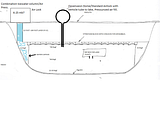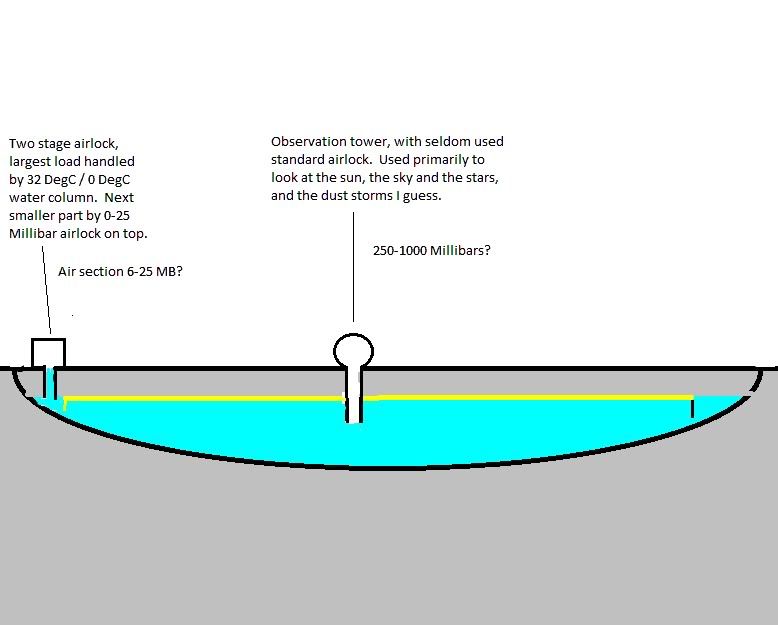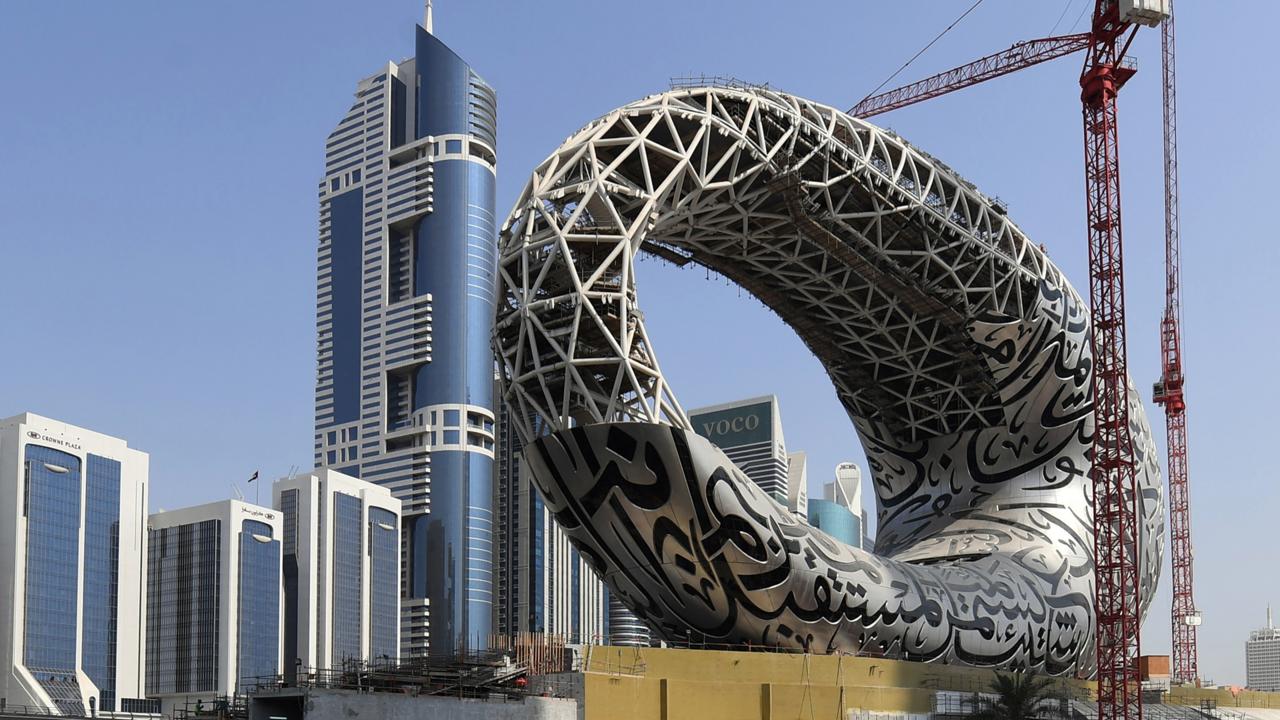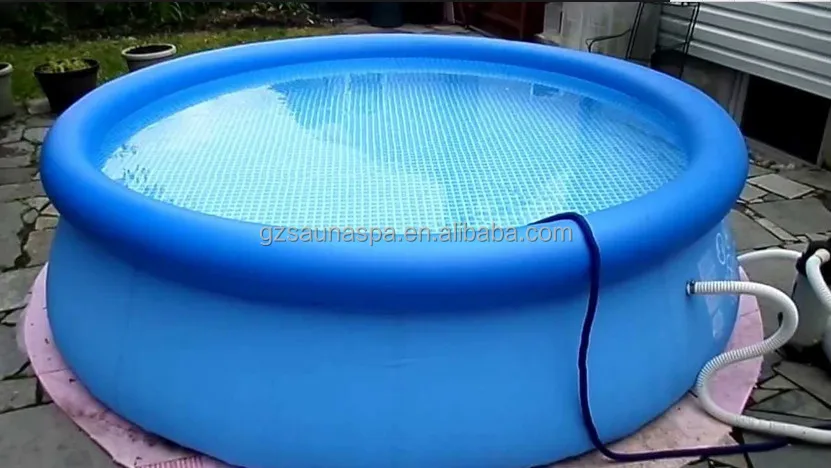New Mars Forums
You are not logged in.
- Topics: Active | Unanswered
Announcement
#51 2012-05-04 14:53:59
- Void
- Member
- Registered: 2011-12-29
- Posts: 9,119
Re: Solar Enclosure Architecture On Mars
Very happy.
Add on airlock/observation pod, 2 stage Air lock 1/2 and most of the pressure differential delt with by a 32-100 foot 32 DegF water column, and a small fraction by a very simple airlock pressurized with Martian Atmosphere.


Large objects through the 2 stage airlock, people also. The observation tower as an airlock? Emergencies only. Otherwise look at the sun and the sky and the stars at night.
Well, I had some problems with that, but anyway the picture is not that good, but you get the idea. The two stage airlock on the left does most of it's work with a water column in a tube where the water is at 32 DegF / 0 DegC. It also requires a standard airlock to handle perhaps 1/40 the of the load, and would do so by moving the air pressure from 6 to 25? Millibars. Of course I have not shown the two sets of doors, 1 at the top of the water column, and 1 to get out to the Martial ambient environment.
The observation tower would mostly be that. See the sun, see the stars. However, it might also be used as an emergency airlock more like a standard airlock, it had such an airlock on a side of it, or in emergencies, it might function like the other air lock. Mostly it would be a observation tower to help keep sanity.
Speeking of sanity, it's Friday. Talk to you later. ![]()
Last edited by Void (2012-05-04 15:37:35)
Is it possible that the root of political science claims is to produce white collar jobs for people who paid for an education and do not want a real job?
Offline
Like button can go here
#52 2012-05-04 17:07:09
- SpaceNut
- Administrator
- From: New Hampshire
- Registered: 2004-07-22
- Posts: 30,062
Re: Solar Enclosure Architecture On Mars
One thing about small ponds is the nature of the marine life to be squeezed out by the plant life in it, not sure how salt water ponds would be any different. Any thoughts on airation to get atmospheric oxygen and even CO2 to disolve into solution for the life that we would subplant into this creation?
Offline
Like button can go here
#53 2012-05-05 10:26:39
- GW Johnson
- Member
- From: McGregor, Texas USA
- Registered: 2011-12-04
- Posts: 6,114
- Website
Re: Solar Enclosure Architecture On Mars
Gases into solution: bubblers like in an aquarium, I guess.
GW
GW Johnson
McGregor, Texas
"There is nothing as expensive as a dead crew, especially one dead from a bad management decision"
Offline
Like button can go here
#54 2012-05-05 11:00:45
- SpaceNut
- Administrator
- From: New Hampshire
- Registered: 2004-07-22
- Posts: 30,062
Re: Solar Enclosure Architecture On Mars
Now that we can make a pond, we can now have fish for part of the crews food supply and other edible plant life as a plus to building it.
Offline
Like button can go here
#55 2012-05-05 13:09:27
- GW Johnson
- Member
- From: McGregor, Texas USA
- Registered: 2011-12-04
- Posts: 6,114
- Website
Re: Solar Enclosure Architecture On Mars
Shellfish, and shrimp, too.
Red Planet Lobster, perhaps?
GW
GW Johnson
McGregor, Texas
"There is nothing as expensive as a dead crew, especially one dead from a bad management decision"
Offline
Like button can go here
#56 2012-05-05 13:16:45
- GW Johnson
- Member
- From: McGregor, Texas USA
- Registered: 2011-12-04
- Posts: 6,114
- Website
Re: Solar Enclosure Architecture On Mars
I think Void may be right. This sort of pond or ice cave thing would work on the Moon, or even the larger asteroids. Anywhere there was ice.
For gravitational induction of pressure by overburden weight, you have to allow for the strength of the gravity. Material depths here for a given pressure get divided by the relative gee there. On Mars it is the Earth depth/0.37. Depths are about 6 times larger on the moon, and way larger on the asteroids.
It would probably be easier and more effective to take at least partial advantage of the structural strength of the ice layer as a pressure shell. But, cracks are leak paths, and ice cracks easily. Failure would be catastrophic. That's a problem yet to be solved.
GW
GW Johnson
McGregor, Texas
"There is nothing as expensive as a dead crew, especially one dead from a bad management decision"
Offline
Like button can go here
#57 2012-05-05 13:36:40
- SpaceNut
- Administrator
- From: New Hampshire
- Registered: 2004-07-22
- Posts: 30,062
Re: Solar Enclosure Architecture On Mars
Quite the case it would seem and here are some of the older threads which we have talked about how to feed the crews on Mars.
Fishsticks: RIP 2048 and Protein Sources in First Colonies - An idea
Offline
Like button can go here
#58 2019-11-10 11:56:36
- tahanson43206
- Moderator
- Registered: 2018-04-27
- Posts: 23,678
Re: Solar Enclosure Architecture On Mars
For SpaceNut ... here is a link that will bring (void) back into view, with his use of the word "architecture" in this topic.
The actual image is from a story about a new building in Dubai, which is preparing for an expo in (I believe) 2020.
However, I think it illustrates the potential for new ideas in architecture which will become possible at Mars due to the lower gravity.

I tried setting this up as an image, but got an error message, so just click on the link to see the image.
(th)
SpaceNut Edit image link to show picture
Thanks SpaceNut ... What you did is what I tried to do, but I'll be able to study your example in future.
(th)
Last edited by tahanson43206 (2019-11-10 18:40:52)
Offline
Like button can go here
#59 2019-11-10 14:57:00
- Calliban
- Member
- From: Northern England, UK
- Registered: 2019-08-18
- Posts: 4,278
Re: Solar Enclosure Architecture On Mars
Excellent idea from Void. Instead of building pressure shells for greenhouses, use hydrostatic pressure instead. One could line a crater or depression with a plastic lining; cover it with a glass greenhouse and fill it with water. Dissolved oxygen concentration is a function of pressure. The hydrostatic pressure at the bottom of the pond, assuming it is about 10m deep, would be sufficient to maintain enough dissolved oxygen for marine life.
The concept could be taken further by stratifying the pool using a layer of polyethylene to prevent mixing of water between two layers. The bottom layer would be warm and oxygenated; the top layer would be relatively cold and free from oxygen and salty to keep it liquid.
One stumbling block is the need for abundant water. Water is an energy intensive product on Mars. Melting buried glaciers would require about 1MJ per kg of water. So a lake 100m x 100m x 10m deep would require 100TJ of heat (27,800MWh) of heat. That is a lot. 1MW of thermal power constantly for 3.2 years. One of the reasons why Mars colonisation will depend on the liberal use of nuclear energy.
Last edited by Calliban (2019-11-10 15:04:46)
"Plan and prepare for every possibility, and you will never act. It is nobler to have courage as we stumble into half the things we fear than to analyse every possible obstacle and begin nothing. Great things are achieved by embracing great dangers."
Offline
Like button can go here
#60 2019-11-10 18:47:01
- tahanson43206
- Moderator
- Registered: 2018-04-27
- Posts: 23,678
Re: Solar Enclosure Architecture On Mars
For Calliban re #59 ...
It is probably time to remind the forum audience that the idea of directing a water containing object to Mars is among the possibilities considered earlier in the forum archive. Comets are particularly interesting, because they are "living" (if that's the word) repositories of water ice, and they announce themselves loudly as they pass through the Solar System.
The day is likely to come when human water miners will collect a part of the bounty of one of these celestial visitors, to bring it to market. The specific market opportunity will depend upon the celestial mechanics involved. Orbital Mechanics (job title) will earn their lofty salaries by computing the optimum navigation for the mining vessel (or fleet) to the object, and to the best paying customer location.
(th)
Offline
Like button can go here
#61 2019-11-10 19:20:54
- SpaceNut
- Administrator
- From: New Hampshire
- Registered: 2004-07-22
- Posts: 30,062
Re: Solar Enclosure Architecture On Mars
The main reason for any size pool of water is to beef up life support systems, waste removal, food production, oxygen creation and to do this with as much natural energy as possible when it comes to mars.
In some of Nasa's documents they show an inflateable ring style pool to hold the water of course with a sealled top to the rest of the unit.

Basic concept is to use multiple inflateable materials tough enough for mars. With the water coming in from the top section with a clear top to allow for some air and co2 to exist in the artificial chamber. water exchange and airation can be accomplished by something simular to the pool filter location. Lets start with a shallow hieght pool inside a dome wihich can be temperature controlled by reflective light from the outside that hits heat obsorbtion areas for later. Channel some of the heat into the pool as need to control the temperature during the night. Even partial pressure can be used for a man in sleeves to enter for short periods of time. After the first is made we can make more for other species to occupy.
Offline
Like button can go here
#62 2019-11-12 11:36:46
- elderflower
- Member
- Registered: 2016-06-19
- Posts: 1,262
Re: Solar Enclosure Architecture On Mars
Better prevent those from freezing. Ice expansion might do a lot of damage to such a design.
Offline
Like button can go here
#63 2019-12-12 17:41:32
- SpaceNut
- Administrator
- From: New Hampshire
- Registered: 2004-07-22
- Posts: 30,062
Re: Solar Enclosure Architecture On Mars
Repost as this works here as well
Here is a twist on such a technology...but when it comes to mars we will want to make use of daily sunlight just as much as we will artificial.
Punching holes in opaque solar cells turns them transparent

Existing transparent solar cells tend to have a reddish hue and lower efficiency, but by punching holes that are around 100 um in diameter (comparable in size to a human hair) on crystalline silicon wafers, it allows light through without coloring. The holes are then strategically spaced, so the human eye is unable to "see" the pattern. The best solar cells on the market have an efficiency of over 20 percent. The transparent neutral-colored solar cell that the research team developed demonstrated long-term stability with a high-power conversion efficiency of 12.2 percent. The next step for the team is to scale up the device to 25 cm2 (3.88 in2) and increase the efficiency to 15 percent. Furthermore, most windows are vertically placed, which causes light to hit the windows at a low angle. When hit by low angle light, the electrical current in conventional cells drops nearly 30 percent, while transparent solar cells reduce less than 4 percent--allowing it to utilize solar energy more efficiently.
http://dx.doi.org/10.1016/j.joule.2019.11.008
Research Report: "Neutral-Colored Transparent Crystalline Silicon Photovoltaics"
This makes it ideal for solar concentrated light to pass as well as to get the energy from the reflected light. This is a benefit to a natural lighted building interior as the panels now become part of the construction and not extra mass to supply energy.
Offline
Like button can go here
#64 2022-08-25 07:19:33
- Mars_B4_Moon
- Member
- Registered: 2006-03-23
- Posts: 9,776
Re: Solar Enclosure Architecture On Mars
How a lake and a volcano produced a rare mineral on Mars
https://www.mining.com/how-a-lake-and-a … l-on-mars/
Aerogels Could Be Used to Build Terraforming Domes on Mars
https://www.discovermagazine.com/the-sc … es-on-mars
Human friendly architectural design for a small Martian base
https://www.sciencedirect.com/science/a … 7711006466
Offline
Like button can go here